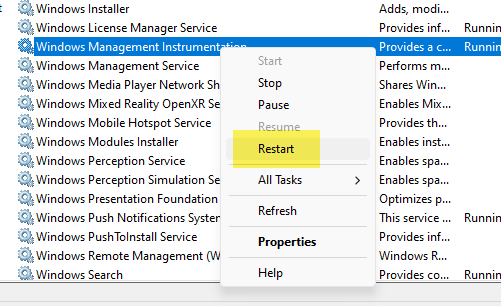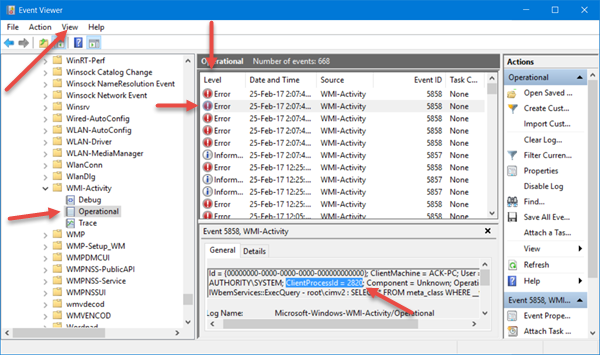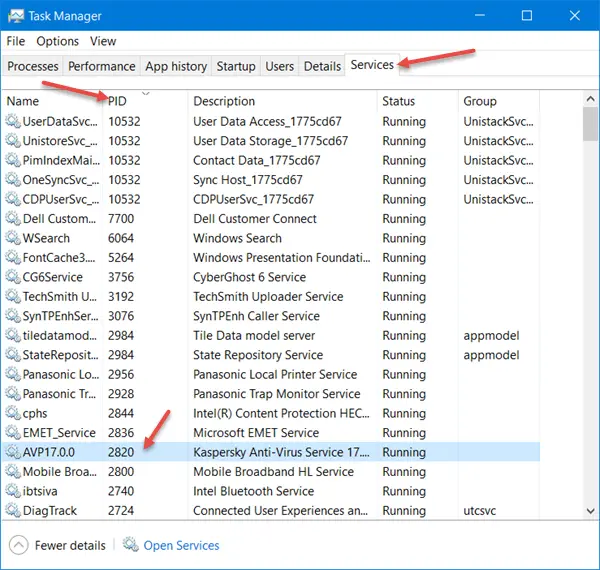At times, you may find that your WMI Provider Host (WmiPrvSE.exe) process is consistently utilizing a significant chunk of the CPU on your Windows 11/10/8/7 computer. There have been reports that sometimes the process ends up using more than 50% of the CPU power, especially when media applications are in use. In this post, we will see how to troubleshoot WMI Provider Host High CPU Usage issue. But before we talk about ways to troubleshoot, let us take a quick look at what WMI Provider Host is.
What is WMI Provider Host?
The service WMI Provider Host (WmiPrvSE.exe) is an acronym for Windows Management Instrumentation Provider Service. This is an important service, and it would be tough to manage applications without this process. If it is stopped, many of the system’s functionalities will become useless. Furthermore, users might not even receive notifications for various errors.
Is WmiPrvSE.exe a virus?
The legit WmiPrvSE.exe or the Windows Management Instrumentation Provider Service process is located in the Windows/System32 folder, but malware can disguise themselves using this name and place themselves in any folder. So Thus, to isolate this possibility, check the Properties of the file and scan it with your antivirus.
How do I stop WMI Provider Host using so much CPU?
Iif you see it using high CPU for WmiPrvSE.exe, run System File Checker to replace potentially damaged system files and see if that helps you. If it does not help, try these suggestions:
- Restart WMI Provider Host Service
- Run System Maintenance Troubleshooter
- Run System Performance Troubleshooter
- Troubleshoot in Clean Boot State
- Check Event Viewer logs.
You will need admin permission for some of these.
1] Restart WMI Provider Host Service

Open Services Manager and locate Windows Management Instrument service.
Right-click on it and select Restart.
2] Run System Maintenance Troubleshooter
Run System Maintenance Troubleshooter. To run the System Maintenance Troubleshooter. Open Run, type the following, and press the Enter key:
msdt.exe -id MaintenanceDiagnostic
Does it help?
3] Run System Performance Troubleshooter
Next, run the System Performance Troubleshooter. To do so, open an elevated Command Prompt, type the following, and hit Enter to run the Performance Troubleshooter.
msdt.exe /id PerformanceDiagnostic
This troubleshooter helps the user adjust settings to improve operating system speed and performance.
4] Troubleshoot in Clean Boot State
Boot the system in Safe Mode with networking. If the system works fine in Safe Mode, then you may need to perform Clean Boot. You have to follow a different procedure to start Windows in Safe Mode. Once there, select the option to start the system in ‘Safe mode with Networking’.
So boot into Clean Boot State and then try and troubleshoot, identify and isolate the offending process manually. Once your work is done, set the system to start normally.
5] Check Event Viewer logs
Ideally, these steps should fix the issue of high CPU usage because of the WMI Provider Host. However, in case the issue remains unresolved, to identify the offending process, you can also use the Event Viewer, then use it to identify errors.
Click the Win+X menu and select Event Viewer. Click on the View menu and select Show Analytic and Debug Logs. Next under Applications and Service Logs > Microsoft > Windows > WMI Activity, locate the Operational log for WMI. Here search for possible errors and note down the ClientProcessID.
Now open the Task Manager > Services tab and click on PID to arrange the processes by PID.
Find the process with the matching process ID under. This is the process that is causing WMI to use excessive CPU.
If you need more help, there is an advanced article on Technet that talks about troubleshooting high CPU usage in WMI components.
Related: WMI Repository reset failed, Error 0x80070005, 0x8007041B, 0x80041003
What is the WMI provider host?
WMI Provider Host (WmiPrvSE.exe) stands for Windows Management Instrumentation Provider Service. When another application requires information about your Windows, then WMI offers a standard way to provide the information. While consumers will not see much use of it, but it is important in Enterprise or wherever the PCs are managed centrally.
Can I Disable WMI Provider Host?
It is possible to disable the WMI by disabling it from the services section. In the Services snap-in, locate the Windows Management Instrumentation service, right-click on it, and disable it. However, it will break things, and it’s best to leave it as it was running.
Can I end the WMI provider host?
No, you cannot end the WMI provider host? WMI Provider Host is an operating system Service and so cannot or should not be permanently stopped or disabled.
Some posts about processes using high resources:


Its funny that culprit in my system was Kaspersky as well. Any suggestions on stopping Kaspersky from harassing my CPU?
over 50%…. ha ha… my pc with i3 chip is having this process use over 80% of cpu… I have screen captures to prove it
What if the process id # found is not listed under services?
Is there a way to find out what it is?
I have a Win7 PC running out of C: space. I ran UnCleaner which cleared 178GB of data. Few days later it ran out of space again. Used Ccleaner this time and it directed me to the C:WindowsTemp folder which was filled to the brim with 20kb log files. Used task manager (sorted by CPU) to find WMIPrvSE.exe sometimes is at the top. Used Process Explorer to suspend it. Deleted all the log files and it stayed empty. Enabled that task and it filled back up again. Can’t find the “Operational log” this article mentioned and any and all other attempts to fix the issue have failed so eventually had to deny access to the log (temp) folder for SYSTEM. Now this task uses 2-3% CPU once in a while and doesn’t fill the hard drive with logs. I know this is a band-aid but works for my situation. What a mess!
Process Explorer. It’s a free utility.